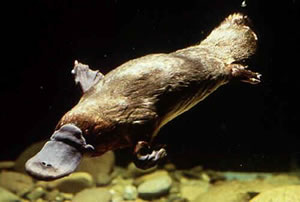Platypus
The platypus is found in eastern Australia. They live aside freshwater rivers or lakes, and create burrows for shelter and protection. They are active mainly at nighttime hours, and use their webbed feet for swimming. When swimming the platypus has its eyes shut. They swim underwater for 2 minutes, before returning to the surface for oxygen. They can however stay underwater for up to 10 minutes, and due to their natural buoyancy, they need to be underneath another object to do this.
The Platypus has a wooly furred coat and range from 30cm to 45cms in length and the tail about 10 to 15 cms. The wooly furred coat actually has three different layers. The first layer keeps the animal warm, by trapping air, the second layer which provides an insulating coat for the animal, and lastly the third layer of long flat hairs to detect objects close by. These creatures weight on average between 1 to 2.4 kilograms. They have an average lifespan of 12 years.
This lifespan may be shortly diminished, as the platypuses biggest threats are snakes, goannas, rats and foxes. Another big threat to the platypus is man, via waterway pollution or land clearing.
Platypuses feed on insect larvae, worms or other freshwater insects. They do so mainly at night, by the use of their bill. They turn up mud on the bottom of the lake or river, and with the help of their electroreceptors located on the bill, find many insects and freshwater insects. They store their findings in special pouches behind their bill, and are consumed upon returning to the surface.




.jpg)








0 comments:
Post a Comment